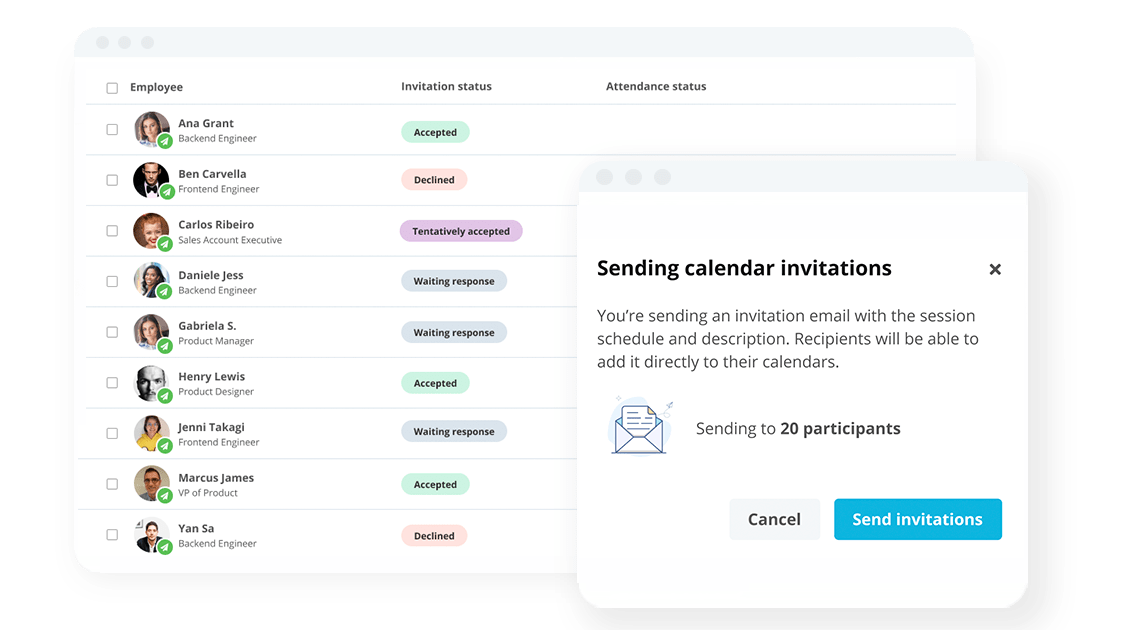
Give the Right Training at the Right Time
Simplify your staff development with centralised training management.
Future-proof Teams With PersonioHow a Reverse Mentoring Program Is Better for Business

Reverse mentoring turns the tables on traditional peer mentoring, bringing fresh new perspectives and lessons to the workplace. Here's what you need to know.
Looking to drive employer performance higher? Look no further!What Is The 5G Workforce?
The 5G workforce refers to the mix of generations that you can find in almost any company today: Traditionalists (Born before 1945), Baby Boomers (1946–1964), Generation X (1965–1980), Millennials (1981–1995), and Generation Z (1996–2012).
And, no, it has nothing to do with phone networks.
Instead, this diverse collection of employees has a lot to learn from each other, and mentorship programs are a great way to facilitate that learning—but who teaches who? That’s where reverse mentoring comes into play.
What Is Reverse Mentoring?
While traditional mentoring typically involves a senior team member mentoring a junior team member, reverse mentoring involves the opposite. The senior team member becomes the mentee, and the junior team member takes the driver’s seat.
Reverse mentoring is built on the idea that two employees can learn a lot from one another, no matter where they are in a company’s hierarchy.
What Is The Purpose Of Reverse Mentoring?
The purpose of reverse mentoring is to break down the traditional mindset that only senior employees have the experience and knowledge fit for mentorship. Junior team members can introduce their mentees to a new way of thinking, teach them new technologies, and help them fill in knowledge gaps.
Reverse training doesn’t have to be a formal process. It could involve casual one-to-one meetings over coffee, or you could bring together several mentors and mentees for small group discussions about a specific topic or skill.
Develop Staff With Ease

Track training attendance, progress and compliance across your organisation from one central, easy-to-use tool.
Future-proof Teams With PersonioHow Reverse Mentoring Helps Your Business
Reverse mentoring requires dedicated mentors, open-minded mentees, and a well-designed program. With this combination, your company can experience improvements across the board, including:
Higher Retention Rates
Companies rated highly on employee training see 53% lower attrition than those who don’t, and reverse mentoring provides employees with a new kind of training that goes beyond coursework and quizzes.
Two of the top benefits that can persuade an employee to stay in their role are development/training courses and clear progression plans. Workers are constantly seeking new development and learning opportunities, and if they can’t find it at your company, they’ll start searching elsewhere.
Modern Skill Development
Today’s diverse workforce comes with generational gaps in knowledge, culture, and technology. What’s second nature to Gen Z doesn’t come as easily to Baby Boomers, and vice versa. Reverse mentoring can be especially effective in helping senior-level employees develop their digital skills, like becoming more comfortable with new software, online tools, or social media.
A More Connected Culture
With reverse mentorships, you can bring together employees who may not otherwise have the opportunity to learn from each other and build a connection. Your employees will have the opportunity to share their different perspectives, creating a more inclusive environment for all.
It can also help build a more comprehensive shared knowledge of the company, processes, and products.
Well-Developed Leaders
Senior team members may have years of leadership experience, but reverse mentoring puts junior employees in the driver’s seat. They can finesse their managerial skills during this time, like communication, active listening, and problem-solving.
It’s also a unique opportunity for them to talk freely with those in senior/leadership positions, from whom they can obtain career advice and plan out their career progression.
More Creative Teams
When you bring people with different skills and experiences together, it encourages them to develop fresh ideas and consider perspectives from outside their regular sphere of influence.
These mentorships can help both parties approach problems or ideas in new and creative ways, or get them more comfortable with the tools they need to get creative in their work.
Develop Staff With Ease

Track training attendance, progress and compliance across your organisation from one central, easy-to-use tool.
Future-proof Teams With PersonioThe 5 Key Principles That Inform Reverse Mentoring
Reverse mentorships require more than a step-by-step program (although we’ll outline one for you in just a moment). They need a true partnership between the mentor and mentee that’s built on five key principles:
1. Compassion
Mentees can often feel vulnerable because they’re afraid of showing their lack of knowledge or experience in a subject to a junior employee. Ensure that everyone involved understands that the program is a judgment-free zone and that everyone involved is committed to that understanding.
2. Mutual Respect
Navigating generational gaps in the workplace can feel intimidating for everyone involved. Both parties must respect each other and the program before it starts; it may help to set aside some time before the official program launch for the mentor and mentee to get to know each other and build a relationship before diving in.
3. Transparent Communication
Both mentor and mentee need to feel comfortable enough to communicate honestly and authentically—it’s the only way to build a strong connection and learn from the experience. Mentors, specifically, may need support and guidance from the program coordinator when it comes to confidently communicating with their mentees.
4. Willingness To Learn
One common mistake with reverse mentorship is when senior-level mentees aren’t open to learning from their junior mentors. This often comes back to issues related to respect. It goes both ways, too. Mentor and mentee must enter into the program with an open mind, willingness to listen without judgment, and a desire to learn with humility.
5. Commitment
All mentorships are a commitment of time and energy. Before starting, make sure the mentor and mentee have the time, workload, and mental energy needed to see success. You should also clearly lay out what the program entails, their expectations, and how long it will be.
Develop Staff With Ease

Track training attendance, progress and compliance across your organisation from one central, easy-to-use tool.
Future-proof Teams With Personio6 Steps To Building A Reverse Mentoring Program
Reverse mentorship programs involve a lot of strategic match-making. Not only between a mentor and mentee, but between your company and your goals.
Use the guide below to build a mentorship that helps your company and your team members reach their next target:
1. Set Your Objective
First, what’s your objective for the program? What’s the most important lesson you want your employees to learn from their experience? This may be:
A hard skill, like learning a specific tool or program
A soft skill, like communication or leadership
Identifying skill gaps
Determining processes that can be improved
Improving social media skills and digital literacy
A more connected and inclusive workplace culture
Outline your goal, the method you’ll use to achieve it, what qualifies as a success, and how you’ll measure that success. Formalize the plan by completing the necessary paperwork that includes your methods and targets, and share it with the appropriate team members as needed.
2. Design The Program
Next, it’s time to design the program. Determine which departments will be involved in the program, which roles should be partnered together, and which individuals should be partnered together.
You’ll also want to establish the number of mentorships you can run simultaneously and over the course of a year or quarter. When will they take place? How long will they be?
Other considerations include how employees enroll in the program and what incentives you’ll provide to those who participate.
Optional: You may want to provide training for those who join the program to help them sharpen skills such as giving and receiving feedback, goal setting, and time management.
3. Find Your Participants
Now, it’s time to recruit mentors and mentees. You can approach recruitment in a few ways: Select the participants yourself, have an open sign-up for anyone to become a mentor or mentee, or have an application process.
If you move forward with open enrollment, promote the program well before its start date to give workers time to consider it. Share program details on the company’s communication channels, emphasizing the program’s benefits and incentives (if included).
4. Make Your Matches
How will you match your mentors and mentees together? You can partner them based on the department they’re in, the type of skill they want to develop, or which generation they’re in.
You could also match them on a more personal level, basing it on shared common interests or personalities. Pairing introverts with extroverts, for example, can be more productive than pairing introverts with introverts.
5. Program Launch
During your first meeting together, clarify and set everyone’s expectations, provide helpful resources for each participant as needed, and walk them through each step of the process. You’ll also want to establish a system for receiving and providing updates and feedback from both mentor and mentee on an easy-to-use platform.
6. Review And Measure
After the program kicks off, check in regularly to measure how it’s going.
What does the mentee think of the experience so far?
Are they getting closer to reaching their established goals?
What support, if any, does the mentor need to make the program more effective?
Don’t be afraid to refine the program as needed for each mentee-mentorship partnership, as it’s a highly personalized experience.
Move Forward With Reverse Mentoring
If you’re worried about filling program seats, know this: More than a quarter of UK workers want a mentor, but most don’t know how to find one.
By creating a well-constructed reverse mentoring program, you’re bridging the gap while building a more connected, informed, and cohesive work environment for all. Take the first step towards it today.
